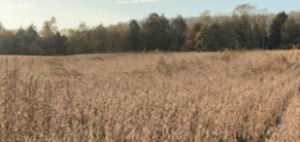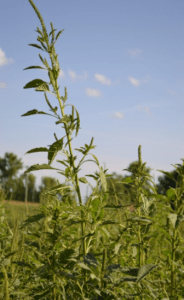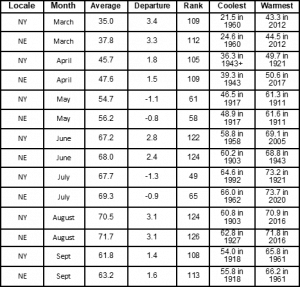
The cropping season is wrapping up. Unfortunately, shlogging through mud was too common for silage harvest. By now, corn silage is in storage and final hay harvests are being made. Yields are slightly above average for corn and reported soybean yields are trending above average at 55 bu/ac and higher. Beans did amazingly well in spite of the excessive rainfall.
A warm fall has been beneficial for cover crop planting and establishment since frost has held off through mid-October. In late September/early October, leaf disease in corn exploded. I suspect the tropical storms that came through back-to-back, starting in mid-August brought the inoculum. A disease that has become more common in the last few years is Northern Corn Leaf Spot. It looks a lot like grey leaf spot, but the lesion has a halo around it. Samples of ‘blighted’ corn that I sent to the lab this fall were identified as Northern Corn leaf spot, also called Carbonum leaf spot and is caused by the fungus, Bipolaris zeicola. I also saw our familiar Northern Corn Leaf Blight. The diseases made the crop look ugly but most of it arrived after the corn crop was made. Corn grain seems to be drying down slowly especially considering the warm temperatures we have had in October. I believe its due to the stress caused by excessive water and the late disease and loss of photosynthetic capacity.


Unfortunately, Tar spot was recently identified in Erie County in NYS. Tar spot has been devastating in the Mid-West this season.
John Winchell of Alltech has been monitoring and troubleshooting mycotoxin levels across the state with the new corn crop. He reported that he is seeing elevated levels of T2, zearalenone and DON or vomitoxin south of the Finger Lakes which includes our region. He believes the early harvested silage should be fine but late harvested corn may have elevated levels.
Mycotoxins in high moisture corn is a concern. John reminds us that when fungi begin to produce mycotoxins when they are under stress. A change in the weather to cooler nights and daytime temperatures will trigger stress for fungi and we need to be aware of the potential for elevated mycotoxin levels in our corn crop in particular. For high moisture corn, you may want to switch from a silage innoculant to proprionic acid to stop further fungi growth.
It is a fall when testing your forage will make sense, particularly if you see any reactions in your herd like going off feed, abortions, immunity challenges, loose manure, sudden milk loss in individual cows, and increased SCC.
On the dry corn side of things, it is important with the combination of Indian summer we have had, as well as increased precipitation, we are seeing slower dry down, and sprouting of corn at the bottom of the ear, from the trapped moisture in the husk. We will not have the luxury of letting mother nature dry the corn down, with this potential fungal growth. We need to check our fields, and get the corn off as well as dry the corn down, so that we can get moisture corn down below 15% moisture to stop fungal growth.
Herbicide Resistant Weeds
I am seeing an increase in Marestail along field edges and in fields. Unmanaged fields that go un-mowed are a potential source of spread. Be on the lookout for the occasional green weed standing above the crop. A single marestail will produce 100,000 seeds and can create a serious problem once established because it is known to be resistant to glyphosate.

Lambsquarter persists as a troublesome weed for control with glyphosate if it gets to big by application time or is hardened by dry conditions. This picture shows tall lambsquarter in soybean not to mistaken for the troublesome pigweeds.
Known infestations of the troublesome pigweeds – palmer amaranth and waterhemp are still very limited in our region. If you notice large weeds that you are unfamiliar with please contact me for identification and recording spread.
If you notice large weeds that you are unfamiliar with please contact me for identification and recording spread.
Overall this growing season was warm and wet. Our field crops turned out ok. Yields are mostly good.

Let’s take a step back and review. Spring arrived early and the season started out warm and dry. March was warmer than normal and dry. It was reported as the 8th driest March for NYS since 1895. May was slightly colder than normal. There were concerns during planting about whether the soil temperatures were warm enough or whether a cold snap would hurt seedlings. The Northeast Regional Climate Center reports that for the Northeast and NY state it was the 15th warmest spring on record with an average temperature of 47.2 degrees F which was 1.5 degrees F above normal.
Although the growing season started out dry especially in May and June, rainfall in July broke records.
July was the wettest on record for NYS and several other NE states. NYS logged 21 days with rain. I’m sure you remember well the first dry spell long enough to harvest hay or haylage that the first week of August gave us. August was also the second hottest on record in the NE with an average temperature of 71.7 degrees F 3.0 degrees F above normal.
Summer 2021 ranked as the sixth hottest summer on record for the Northeast. The region’s average temperature of 69.6 degrees F was 1.5 degrees F above normal. It was NY’s seventh hottest summer. 
We had a number of damaging thunderstorms and torrential downpours throughout the summer. Some with sporadic hail. Some storms causing washouts in fields and roads and downed trees. Rain continued through August, mostly fueled by tropical storms from the Atlantic and Caribbean region. Three were notable for NY – Fred, Henri and Ida. We were soaked by Fred. Henri brought lighter rain but hit the Hudson Valley hard and Ida was a disaster for NYC.

We’ve had an unusually warm fall with no frost in site in mid-Oct. Nights temperatures have mostly stayed on the warm side. The window for winter wheat planting in September was good if soils weren’t too wet. Cover crops appear to be thriving across the region. Grass growth in pastures look like early spring. Some are taking advantage of the abundant hay growth for a late cutting. It has been a great season to rebuild crop inventories. Weather will continue as a key factor in our cropping programs. We need to be thinking about the practices that will hold on to our soil and allow our crops to thrive even as the seasons become less predictable.

NY Temperature Averages (°F) Rankings are for the 127 years between 1895 and 2021. 1=coolest; 127=warmest. Departures are calculated using the 1991-2020 normals. + indicates extreme also occurred in one or more previous years.

NY Precipitation Averages Rankings are for the 127 years between 1895 and 2021. 1=driest; 127=wettest. Departures and percent normal are calculated using the 1991-2020 normals. Reference: NRCC Northeast Regional Climate Center https://www.nrcc.cornell.edu/
